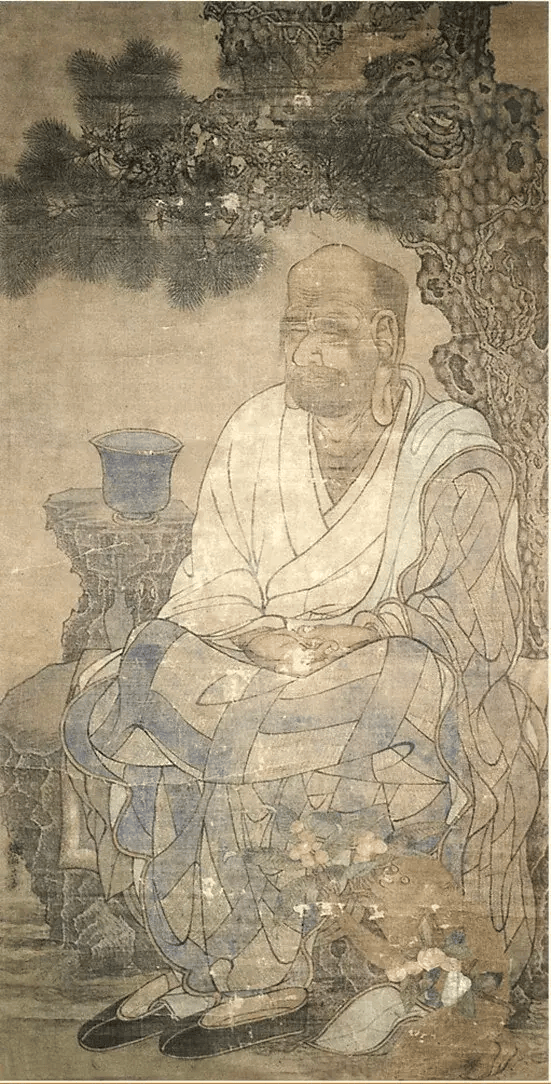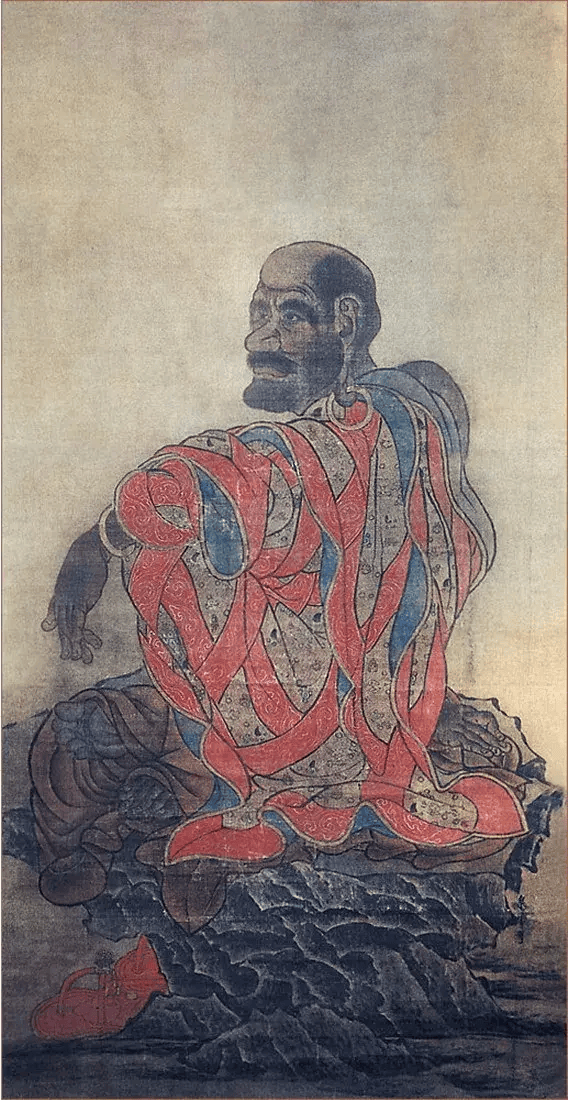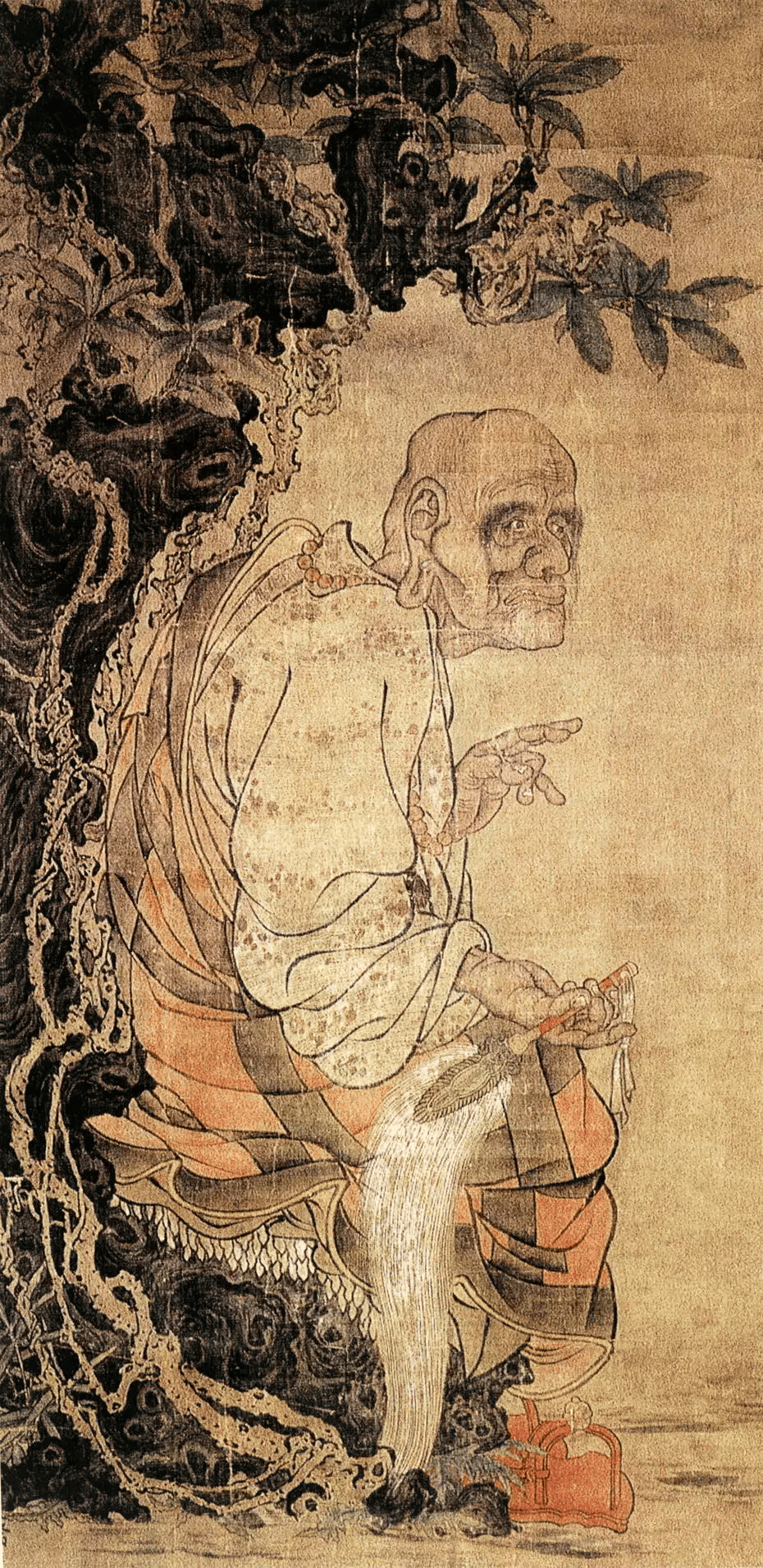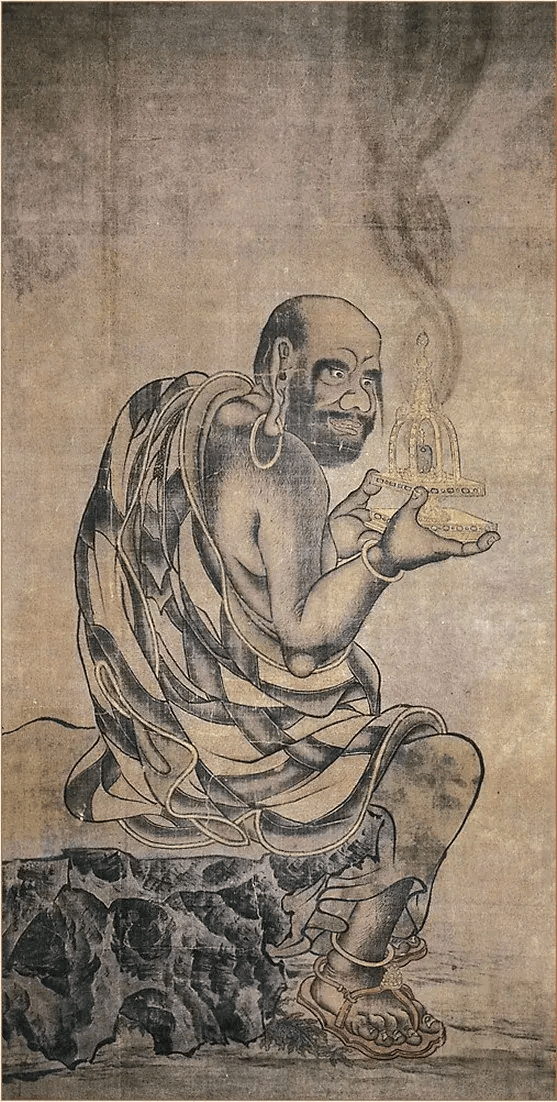
The Sixteen Arhats
The author is Guan Xiu from the late Tang Dynasty and Five Dynasties period.
《十六罗汉图》,贯休画中之绝艳,风格墨法,世所稀见。贯休作画,不仅维摩尊者、高僧肖像,亦有山水之作,而《十六罗汉图》尤为传世。此图今藏日本皇宫,学者谓之宋初摹本,几可谓贯休真迹之近似者也。
"The Sixteen Arhats" stands as a masterpiece among Guan Xiu's paintings, remarkable for both its stylistic flair and brushwork skill, receiving high acclaim through the ages. Guan Xiu's oeuvre includes portraits of Vimalakirti, eminent monks, venerable figures, and the Arhats, with a few landscapes as well. Among these, his "The Sixteen Arhats" is particularly renowned. This version, housed within the Japanese Imperial Palace, is identified by scholars as a Song dynasty replica, the closest to Guan Xiu's original work.
贯休,字德隐,号禅月大师,婺州兰溪人也。自幼出家,少年已成文名,四方游历,与时人诗唱甚多。唐乾宁之初,至吴越献诗钱镠;乾宁末年,至荆南成汭之下,居龙兴寺。因事得罪,曾被放逐至黔中。天复三年,成汭败死,遂入蜀,受前蜀王建之礼,建龙华禅院。乾化二年卒,年八十有一。
贯休之笔,以禅意深远,形象生动,融古典之美,留下不朽之作。其《十六罗汉图》,更是文化瑰宝,传世不息,启迪后人,文风骨鲜明,彰显大师之风范。
Guan Xiu, known as Master Chan Yue, with a secular name of Jiang and hailing from Lanxi in Wuzhou (present-day Lanxi City, Zhejiang Province), was a distinguished poet-monk and painter of the late Tang and Former Shu periods. Having taken monastic vows at seven in Lanxi's Anhe Temple and achieving literary fame by his mid-teens, he traveled widely, engaging in poetic exchanges with contemporaries. In the inaugural year of Tang's Qianning era (894 AD), he presented poems to Wuyue's King Qian Liu. Towards the end of the same year, he visited Jingnan's military governor Cheng Rui, residing in Longxing Temple, and was once exiled to Qianzhong due to offenses. Three years into Tianfu (903 AD), following Cheng Rui's defeat and death, he entered Shu, where he received generous treatment from Wang Jian, the founder of Former Shu, who commissioned the construction of Longhua Zen Monastery for him. He passed away in the second year of Liang's Qianhua era (912 AD), at the age of eighty-one.
Guan Xiu's brush, with its profound Zen spirit and vivid imagery, blendsical beauty to leave an immortal legacy. His "The Sixteen Arhats" especially, a cultural treasure passed down through generations, enlightens successors with its distinctive style, showcasing the grandeur of a master.
鉴赏 Appreciation
















九百年前后,贯休游蜀,至前蜀君前,献诗曰:“一瓶一钵垂垂老,万水千山得得来。”因其诗之情景贴切,结构匀称,遂号为“得得来和尚”。王建喜其至,赐礼甚厚。贯休居龙华寺之禅房,静修禅悟,水墨绘十六罗汉及一佛二菩萨。画中巨石云雾环绕,苍松古藤缠绵,佛、菩萨及罗汉形象,古朴非凡。贯休自谓:“此神佛梦中所见,醒绘之,可谓‘应梦罗汉’。”其弟子昙域、昙弗等珍藏之,视为宝物。
贯休之罗汉,别于世画,形象夸张传神,立意深远。常罗汉图描其超尘拔俗,贯休去此,仅以其日常之态,显超然之风。罗汉各异其形,栩栩如生,风骨古雅,接近罗汉之真。
《十六罗汉图》,续唐代胡人之形,变唐时之写实,罗汉形怪异,神秘莫测。“古谲”二字,形容之最宜——“古”之沉静神秘,与“谲”之奇特夸张,显画之独特韵味。此罗汉,非单纯艺术,乃贯休禅思所化,禅境之幻象,令观者于奇异之美感神秘真实之境。
Around the year 900, Guan Xiu wandered into Shu, presenting a poem before the lord of Former Shu, which read: "With a bottle and a bowl I age, through a thousand waters and a thousand mountains I freely roam." For its fitting imagery and balanced composition, he was thus nicknamed the "Freely Roaming Monk." King Jian delighted in Guan Xiu's arrival, bestowing him with lavish gifts. Guan Xiu resided in the Zen chamber of Longhua Temple, meditating and contemplating in solitude, and painted sixteen Arhats, along with one Buddha and two Bodhisattvas in ink. The paintings were surrounded by massive rocks shrouded in mist, with ancient pines and vines intertwining, while the visages of Buddha, Bodhisattvas, and Arhats displayed an extraordinary antiquity, distinct from other artists' renditions. Guan Xiu often remarked, "These divine beings appeared to me in dreams, and upon waking, I painted them; they might well be called 'Dream-Inspired Arhats.'" His disciples, Tan Yu, Tan Fu, and others, treasured these works as invaluable artifacts.
Guan Xiu's depiction of Arhats, compared to those by other artists, was not only more vivid and exaggerated but also unique in conceptual design. Whereas typical Arhat paintings often depict them performing miracles or being revered by dragons and spirits, Guan Xiu abandoned these motifs, focusing instead on the Arhats' transcendental expressions through their mundane postures. Each Arhat, distinct in character, seems to leap off the canvas, exuding an ancient and noble air that approaches the true essence of Arhats.
Guan Xiu's "Sixteen Arhats" followed the depiction of foreign figures in Tang dynasty Buddhist art but diverged from the secularized and realistic Tang Buddhist statues. His Arhats were dramatically transformed into bizarre figures imbued with a sense of mystery and awe. Described as "anciently bizarre," the "ancient" reflects the serene mystery, while "bizarre" highlights their exaggerated oddity, contributing to the unique charm of Guan Xiu's paintings. These Arhats were not merely artistic creations but the visual manifestations of Guan Xiu's profound meditations on Zen, embodying the fantastical realms of Zen Buddhism, inviting viewers into a realm of profound mystery and authenticity through their unusual beauty.
(文中图片来自网络 版权归原作者所有)
责任编辑:苗君